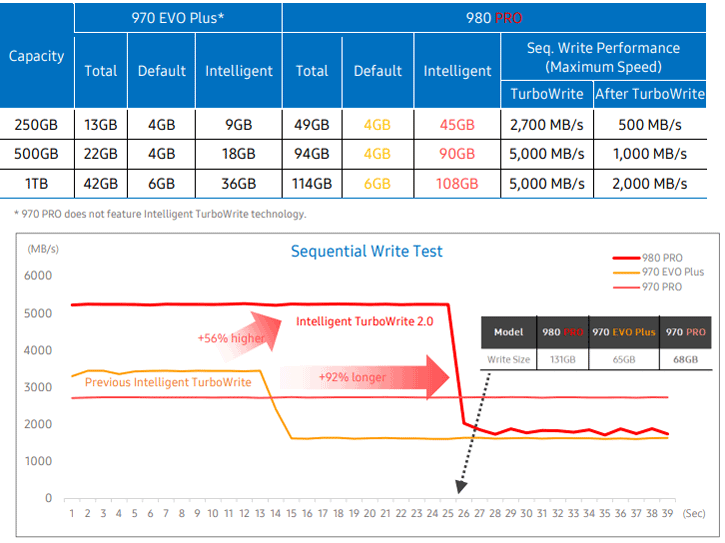Specifications & Features
Specifications & Features
The sample that has arrived for testing is the 1TB version of the drive. The series, as stated, will be fitted with 128-layer TLC written (3-bits per cell) 3D NAND flash memory (vertically stacked). MLC or TLC? Well, Samsung is listing this at MLC, but when you write 3-bits per NAND cell, really that is TLC. So instead of using Planar NAND, 3D NAND is used. 3D TLC NAND is a physical vertical NAND cell stacking not to be confused with chip stacking in a multi-chip package. In 3D NAND, NAND layers, not chips, are stacked in a single IC. The good news is continued cost reduction, smaller die sizes, and more capacity per NAND chip. Also, installed NAND toolsets in the wafer fabs can, for the most part, be reused, thereby extending the useful life of fab equipment. A Samsung controller drives the NAND ICs, there is a DRAM cache as well as SLC provisioning. Samsung uncovered the Samsung 980 Pro on a product page on its website a few weeks ago. There will be 250 GB, 500 GB, and 1 TB versions. Listed are some blazing performances, sequential read and write speeds are listed at 7000 MB/s and 5000 MB/s, respectively. Samsung is pitching 4KB random read speeds of up to one million IOPS in the best circumstances with the 1TB model, up to 60,000 IOPS in the most adverse cases with 4K random writes. The NAND storage store methodology for the 980 Pro is TLC based (so three bits per cell written), and not MLC as opposed to the documentation.
Endurance
A cumbersome hindrance with the product series is that Samsung has lowered the endurance levels of this drive series, it has become less or more restricted compared to the last generation 970 Pro series. It's is listed being 600 terabytes written for the 1 TB model (TBW), and that value was was 1200 TBW for the 970 Pro; it is even less than the 960 Pro, which was listed at 800 TBW. With a warranty of 5 years or the respective TBW value depleted, you should see this puppy last a while, though. Do you have Samsung SSD Magician installed? Well, here what Samsung does with your data, they performed a study based over more than half a million users shows that in five years you will have written less than 156 TB, that goes for 99% of the consumers.
While we feel 600 TBW is a big step back, we also need to realize that such a TBW value for a generic consumer is not an issue. If you write 50GB of data each and every day in a year, that's 18.25 TBW per year. 600:18.25 TB = almost 33 years of lifespan. That said, the endurance would matter more for video editing platforms and servers.
Controller
TurboWrite has been updated up to 131 GB
980 PRO features newly enhanced Intelligent TurboWrite 2.0 technology. Compared to the previous Intelligent TurboWrite, Intelligent TurboWrite 2.0 provides up to 5 times larger buffer (TurboWrite region). With the 1TB model, for example, the pre-allocated (default) TurboWrite region is 6GB (your pSLC buffer), and it can also allocate an additional 108GB to be used as a dynamic SLC buffer to increase the total SLC buffer to 114GB. The performance of PCIe 4.0 can be experienced under large workloads without declining performance. According to internal test results, the 980 PRO’s Intelligent TurboWrite 2.0 can transfer about 131GB data in 26 seconds while the 970 EVO Plus with Intelligent TurboWrite transfers only 65GB and 970 PRO delivers 68GB in the same time frame. In terms of duration, Intelligent TurboWrite 2.0 can be sustained for 26 seconds, approximately 92% longer than the 13 seconds of the previous Intelligent TurboWrite.
The Intelligent TurboWrite region takes advantage of idle capacity, so if the SSD does not have more than 324GB of free space for the 1TB model, intelligent TurboWrite will not fully operate. This algorithm does not affect SSD endurance because the total amount of data users write on the SSD is unchanged.





